On this page
New World WarblersThis page lists books about New World Warblers.The books are listed in order of publication date with the most recent at the top.
Warbler species
Family: Parulidae
There are about 100 species of New World Warblers (aka Wood Warblers). This group includes Warblers, Parulas, the American Redstart, the Ovenbird, Waterthrushes, Yellowthroats and Whitestarts. These birds are restricted to the Americas and are not related to the Old World Warblers or the Australian Warblers.
|
|
|
|
North American Warbler Fold-Out GuideScott Whittle, Tom Stephenson
Princeton University Press
2016
"This is a handy, pocket-sized foldout reference to the 45 most commonly seen North American warblers. Photos include side-on, underside, and 45-degree views. Drawings of undertail patterns provide at-a-glance comparisons between species. Icons depict generalized color patterns for each bird and where the species is usually found--on the ground, low in trees or vegetation, midstory, or toward the top of trees. Succinct text describes key identification features for each species. A QR code takes you to a range of common vocalizations for each species."
|
Buy from amazon.co.uk 
|
|
Warblers in Your Pocket: A Guide to the Wood-Warblers of the Upper MidwestDana Gardner, Holly Carver
Bur Oak Laminated Field Guides: 28
University of Iowa Press
2016
"This newest addition to Iowa's popular series of laminated guides – the twenty-eighth in the series – illustrates the thirty-eight species of warblers that occur in the Upper Midwest states of Minnesota, Illinois, Nebraska, Kansas, North Dakota, South Dakota, Iowa, Indiana, Michigan, Ohio, and Wisconsin. For each species, artist Dana Gardner provides length, range, and habitat; he illustrates male, female, and immature birds where plumage varies; and he includes birds similar to warblers such as kinglets and vireos."
|
Buy from amazon.co.uk 
|
|
Golden-winged Warbler Ecology, Conservation, and Habitat ManagementEditors: Henry M. Streby, David E. Andersen, David A. Buehler
Studies In Avian Biology 49
American Ornithological Society / CRC Press
2016
"Golden-winged Warblers (Vermivora chrysoptera) are migratory songbirds that breed in temperate North America, primarily in the Great Lakes region with remnant populations throughout the Appalachian Mountains, and winter in Central and northern South America. Their breeding range has contracted dramatically in the Appalachian Mountains and many populations have dramatically declined, likely due to habitat loss, competition and interbreeding with Blue-winged Warblers (Vermivora pinus), andglobal climate change.. As a result of population declines in much of the eastern portion of their breeding range, Golden-winged Warblers are listed as endangered or threatened in 10 U.S. states and in Canada and have been petitioned for protection under the U.S. Endangered Species Act. This book compiles extensive, current research on Golden-winged Warblers and summarizes what is known and identifies many remaining unknowns, providing a wealth of peer-reviewed science on which future research and listing decisions can be based."
|
Buy from amazon.co.uk
Buy from amazon.com
|
|
52 Small BirdsRichard Weeks
Luminare Press
2014
"52 Small Birds describes the eight year quest of a bird artist to photograph and paint the 52 breeding warblers of the United States. Comfortably retired and enjoying his passion as an artist, the author was in his 60s when he discovered the joys and challenges of birding. His desire—perhaps more rightly described as a fixation—to document warblers led to 11 trips to eight different states, which are described in narration, journal sketches, photographs, and paintings. This narrative relates how the process of searching for, photographing, and painting birds both enhanced and deepened the author’s connection to the natural world."
|
Buy from amazon.co.uk 
|
|
Sex and Age Differences in Site Fidelity, Food Resource Tracking, and Body Condition of Wintering Kirtland's Warblers (Setophaga kirtlandii) in the BahamasJoseph M. Wunderle Jr., Patricia K. Lebow, Jennifer D. White, Dave Currie and David N. Ewert
Ornithological Monographs 80
American Ornithologists' Union
2014
From the abstract: "Distribution of nonbreeding migrant birds in relation to variation in food availability has been hypothesized to result from the interaction of dominance hierarchies and variable movement responses, which together may have sex- and age-specific consequences. We predicted that site fidelity, movements, and abundance of Kirtland's Warblers (Setophaga kirtlandii) wintering on the island of Eleuthera in the Commonwealth of the Bahamas (hereafter "The Bahamas") would be correlated with food abundance but vary by sex and age. We found that the species' food resources (fruits and arthropods) typically declined during a winter but varied between winters (years) and study sites. Rainfall is a driver of variation in fruit abundance, as indicated by an information-theoretic evaluation of abiotic factors that influence fruit abundance. Despite variation in food availability, the proportions of fruits and arthropods in the diet of Kirtland's Warblers (88% of 90 fecal samples with both) varied little within or between winters or with sex or age class. Overwinter site persistence was low and variable among study sites (average = 43%, range: 11–67%); as predicted, site fidelity within and between winters differed by sex (males > females) and age class (adults > juveniles). However, knowledge of only sex and age was insufficient to predict site persistence in a model-selection framework in the absence of other contributing variables from the confidence set of models (i.e., food resources and/or habitat structure) for two model sets. These analyses further indicated that measures of food resources, either foliage arthropods or fruits, were reliable positive predictors of site fidelity, given the respective confidence set of models."
|
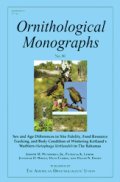 |
|
The Warbler GuideTom Stephenson and Scott Whittle
Princeton University Press
2013
"Warblers are among the most challenging birds to identify. They exhibit an array of seasonal plumages and have distinctive yet oft-confused calls and songs. The Warbler Guide enables you to quickly identify any of the 56 species of warblers in the United States and Canada. This groundbreaking guide features more than 1,000 stunning color photos, extensive species accounts with multiple viewing angles, and an entirely new system of vocalization analysis that helps you effectively learn songs and calls."
|
Buy from amazon.co.uk 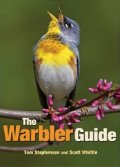
|
|
The Kirtland's Warbler: The Story of a Bird's Fight Against Extinction and the People Who Saved ItWilliam Rappai
University of Michigan Press
2013
"In The Kirtland's Warbler, William Rapai explores the bird's fascinating natural history as well as the complex and evolving relationships between the warbler, its environment, its human protectors, and state and federal policies that today threaten to eradicate decades of work done on the species' behalf. Beginning with an account of the warbler's discovery in the mid-nineteenth century and ornithologists' desperate hunt for information on the elusive new species, the book goes on to examine the dramatic events that quickly led to the warbler's precarious status and its eventual emergence as a lightning rod for controversy. The Kirtland's warbler is often described as a "bird of fire" for its preference for nesting in areas cleared by wildfire. But it also warrants the name for the passion it ignites in humans. Both tragic and uplifting, the story of this intriguing bird is a stirring example of how strong leadership, vision, commitment, sustained effort, and cooperation can come together to protect our natural world."
|
Buy from amazon.co.uk 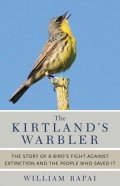
|
|
Cerulean Blues: A Personal Search for a Vanishing SongbirdKatie Fallon
Ruka Press
2011
"Taking the reader from the mountains of Appalachia to a coffee plantation near Bogotá, Colombia, this investigation into the plight of the cerulean warbler – a tiny migratory songbird – describes its struggle to survive in ever-shrinking bands of suitable habitat. This elusive creature – a favorite among bird watchers and the fastest-declining warbler species in the United States – has lost three percent of its total population each year since 1966. This precipitous decline means that today there are 80 percent fewer ceruleans than 40 years ago, and their numbers continue to drop because of threats including deforestation, global warming, and mountaintop-removal coal mining. With scientific rigor and a sense of wonder, Fallon charts their path across more than 2000 miles and shows how the fate of a creature weighing less than an ounce is vitally linked to that of our own."
|
Buy from amazon.co.uk 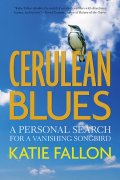
|
|
The Warbler RoadMerrill Gilfillan
Flood Edition
2010
"In these twenty-six short essays, Merrill Gilfillan records his encounters with wood warblers as they flit through North American landscapes on their migratory paths. With precision, appetite, and a touch of whimsy, he sketches the tiny birds in their surroundings, perfecting the art of what he elsewhere calls "alfresco writing." Throughout, The Warbler Road testifies to birding as a meditative, even votive dedication and a fundamental mode of attention to the world: "When I walk out with binoculars in May and September, it is often the fly fisherman in Yeats's poem I have in mind as I move along the path. We are both out to discover and authenticate the morning, to break the glaze of habitude and mark, for an hour or so, the weave and fine points of the season and its day-in-place."
|
Buy from amazon.co.uk 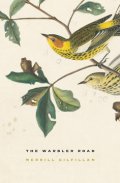
|
|
Golden Wings & Hairy ToesTodd Mcleish
University Press of New England
2007
"This book profiles fourteen of New England’s most rare and endangered flora and fauna—mammals, birds, insects, plants, and fish—by following the biologists who are researching, monitoring, and protecting them. Each chapter includes a first-person account of the author’s experience with these experts, as well as details about the species’ life history, threats, and conservation strategies. McLeish traps bats in Vermont and lynx in Maine, gets attacked by marauding birds in Massachusetts, and observes the metamorphosis of dragonflies in Rhode Island. He visits historical cemeteries to see New England’s rarest plant, tracks sturgeon in the Connecticut River, and observes a parade of what may be the rarest mammal on earth, the North Atlantic right whale, in Cape Cod Bay. The book’s title comes from the name of one of the birds in the book, the golden-winged warbler, and the unusual characteristic used to distinguish the rare Indiana bat from its common cousins, its hairy toes. McLeish, a longtime wildlife advocate and essayist, has a gift for communicating scientific information in an interesting and accessible way. His goal in this book—to make an emotional connection to a variety of fascinating animals and plants—is successfully conveyed to the reader, who comes away amazed by the complexity of individual species and the ecosystems necessary for their survival."
|
Buy from amazon.co.uk 
|
|
Field Guide to WarblersDonald Stokes, Lillian Q. Stokes
Stokes Field Guide
Little Brown and Company
2004
A 172 page identification guide to North American Warblers.
|
Buy from amazon.co.uk
Buy from amazon.com
|
|
Warblers of the Great Lakes Region and Eastern North AmericaChris G Earley
Firefly Books
2003
"Describes the 42 species of Warbler found in the Great Lakes region and Eastern North America. Species are presented in taxonomic order to show how they relate to each other. The text includes information on biological classification, distinctive markings, seasonal plumage changes, song description and behaviour. and explains why they are so difficult to spot. Comparison pages are also provided which group similar-looking birds on a single spread for quick reference. Includes many colour photographs."
|
Buy from amazon.co.uk
Buy from amazon.com
|
|
Chasing WarblersVera Thornton and Bob Thornton
Corrie Herring Hooks Series
University of Texas Press
1999
"An account of the authors travels locating and photographing the 52 species of North American wood warblers. They describe where and how they photographed each species and describe some of the human characters they met on their journeys."
|
Buy from amazon.co.uk
Buy from amazon.com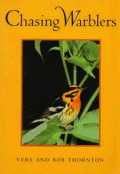
|
|
The Wood Warblers: An Introductory GuideBarth Schorre and John Rappole
Corrie Herring Hooks Series
University of Texas Press
1998
"A beginner's pictorial guide to identification of 49 wood warbler species of the US and Canada. After information on distribution, diminishing numbers, migration, and attracting warblers, a gallery of birds offers colour photos for each entry showing males and females, and describe characteristics, range, and abundance."
|
Buy from amazon.co.uk
Buy from amazon.com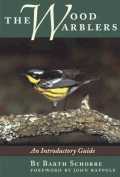
|
|
WarblersJon L Dunn and Kimball L Garrett
Peterson Field Guides
Houghton Mifflin
1997
"A guide to the 60 species of North American Warblers. Each species is described in detail, from its field marks to its mating habits and plumage. Precise range maps show where each species can be seen at different times of the year."
|
Buy from amazon.co.uk
Buy from amazon.com
|
|
New World Warblers: An Identification GuidePublished in the USA as:Warblers of the Americas: An Identification GuideJon Curson
Illustrations: David Quinn and David Beadle
Christopher Helm
1994
"The guide provides an identification introduction to the American Warblers (family Parulinae) which are distributed through North, Central and South America. The introduction is followed by individual species text describing identification, range voice, habitat and behaviour. There are 36 colour plates, "wing-formulae" drawings and distribution maps for each species."
|
Buy from amazon.co.uk
Buy from amazon.com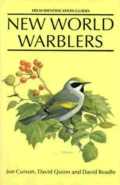
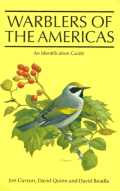
|
|
American Warblers: An Ecological and Behavioural PerspectiveD.H. Morse
Harvard University Press
1990
"A monograph on the New World Warblers. The author reviews their evolutionary history and their dispersal through North and South America, their life cycle, both in breeding and migration, as well as aspects of their foraging behaviour, habitat selection, mating, reproduction, plumage, rare and tropical species, and diversity."
|
Buy from amazon.co.uk
Buy from amazon.com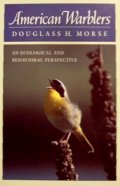
|
|
An Analysis of Physical, Physiological and Optical Aspects of Avian Coloration with Emphasis on Wood-WarblersEdward H Burtt
Ornithological Monographs 38
American Ornithologists' Union
1986
A 122 page study.
|
Buy from amazon.co.uk
Buy from amazon.com |
|
Bachman's Warbler: A Species in PerilPaul B. Hamel
Smithsonian Books
1986
|
Buy from amazon.co.uk
Buy from amazon.com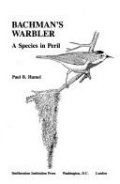
|
|
Wood Warblers' WorldHal H. Harrison
Simon & Schuster
1984
|
Buy from amazon.co.uk
Buy from amazon.com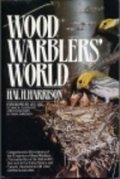
|
|
Kirtland's Warbler: The Natural History of an Endangered SpeciesLawrence H. Walkinshaw
Wayne State University Press
1983
|
Buy from amazon.co.uk
Buy from amazon.com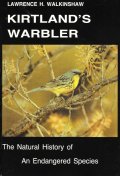
|
|
The Warblers Of AmericaEditor: Ludlow Griscom and Alexander Sprunt Jr.
Revised and updated by Edgar M. Reilly, Jr
Illustrations: John Henry Dick
Doubleday
Revised edition
1979
|
Buy from amazon.co.uk 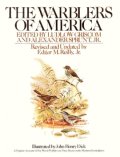
|
|
The Golden-Cheeked WarblerWarren M. Pulich
Texas Parks and Wildlife Press
1976
|
Buy from amazon.co.uk 
|
|
Natural History Of The Swainson's Warbler
Brooke Meanley
North American Fauna, Number 69
Bureau Of Sport Fisheries And Wildlife
US Department Of The Interior
1971
From the introduction: The Swainson's Warbler (Limnothlypis swainsonii) is one of the least known of songbirds in the southern United States and one that is widely sought by bird enthusiasts. It is unusually appealing to the student of birds because it is hard to find, because its forbidding habitat is challenging, and because it is associated with the Audubon-Bachman period of North American ornithology. The difficulty of becoming well acquainted with the Swainson's Warbler has been noted by a number of field ornithologists. In the Alabama River bottoms, Arthur H. Howell of the U.S. Biological Survey reported it as confined to the deep swamps and riverbottom woods where canebrakes occur, and re- marked that its secretive habits conceal it from all but the most persistent observers. In the big swamps above Mobile in May 1911, July 1913, and May 1914 he heard at least nine of these warblers, but because of the impenetrable vegetation was unable to collect any. Maurice G. Brooks, Professor of Wildlife Management at West Virginia University, and his coworker W. C. Legg found this elusive warbler extremely difficult to observe in the dense shadows of the "rhododendron hells" of the Alleghenies: With their neutral brown coloration, their rapid movements, and their ap- parent liking for the centers of the thickets, they seemed to blend imperceptibly into their surroundings.
|
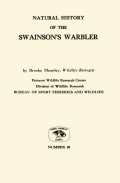
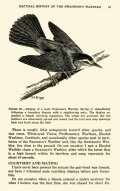
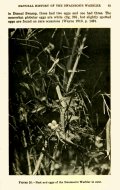 |
|
Kirtland's WarblerHarold Mayfield
Cranbrook Institute Of Science
1960
|
Buy from amazon.co.uk
Buy from amazon.com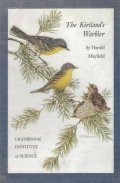
|
|
The Warblers Of North AmericaEditor: Ludlow Griscom and Alexander Sprunt Jr.
Illustrations: John Henry Dick
Devin-Adair
1957
|
Buy from amazon.co.uk
Buy from amazon.com
|
|
Life Histories Of North American Wood Warblers: Order PasseriformesArthur Cleveland Bent
Smithsonian Institution
1953
Subsequently reprinted in two volumes.
|
Buy from amazon.co.uk
Buy from amazon.com
|
|
The Warblers Of North AmericanFrank M. Chapman
Illustrations: Louis Agassiz Fuertes and Bruce Horsfall
D. Appleton & Company
1907
Includes 24 colour plates. From the preface: The warblers have been described as "our most beautiful, most abundant, and least known birds." The knowledge that at certain seasons our woods, and even the trees of our larger city parks are thronged with an innumerable host of birds, the brilliancy of whose plumage rivals that of many tropical species, comes to the bird student with the force of a surprising discovery. One never forgets one's first Warbler! Highly migratory, the extended journeys of Warblers are nevertheless performed with regularity which makes their appearance in the spring a fixed calendar event. The very essence of the season is in their flitting forms and lisping voices; without them May would seem a dreary month and the migration of birds lose half its charm. But these dainty, fascinating sprites of the tree-tops are elusive. Years of observation may be required to add to one's list of field acquaintances the last of the thirty-odd species which, in eastern North America, may be found at a single locality. In this quest the field-glass student is handicapped. The small size of Warblers, their activity, the nature of their haunts, their rapid journeys, marked seasonal changes in plumage, and the general resemblance in the song of many species all tend to render recognition in life unusually difficult. This book has, therefore, been prepared with the cooperation of other ornithologists, to meet the demand for a fully illustrated work which will serve as an aid to the field identification of Warblers and to the study of their life-histories.
|

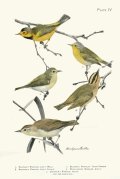
 |
|
The Warblers Of New England
C.J. Maynard
1905
Published in 6 parts between 1901 and 1904
From the prospectus: "This work contains descriptions of ail of the species of American Warblers which are found in New England. The book is illustrated with twelve hand-colored plates on which are figured a male and female of each species. THIE TEXT. The Family characters are first given, both external and internal, followed by a comparison with allied families. Generic characters are then defined in a clear, concise manner, and descriptions of species follow. The size is first given, then the characteristic markings, the time of migration and breeding range. This portion of the text is in large type. Following this, in smaller type, is a detailed description of the adult male and female, then of the young, and when known, of the nestling. Dimensions are next given; then comparisons with allied species, a feature particularly valuable to those who are comparatively unfamiliar with birds. Careful descriptions of the nests and eggs are given. The text on habits is in large type. This is a general account of the species, a more detailed account of the song, migration, and breeding range follows. ILLUSTRATIONS. One of the advantages of this book are the illustrations; many of the characters mentioned are explained by wood cuts, engraved by the author. PLATES. There are twelve plates, on each of which are given life-sized heads of both sexes of all of our warblers. These plates are engraved and hand-colored by the author."
|
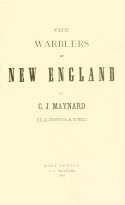
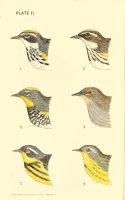
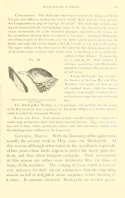 |
|
Distribution And Migration Of North American Warblers
Wells W. Cooke
Division Of Biological Survey Bulletin No. 18
US Department of Agriculture
Government Printing Office
1904
From the introduction: The warblers are birds of wide distribution. They occur in summer in greater or less abundance over nearly the whole of North America except the arid lands of the Southwest and the Barren Grounds of the far North. Though of small size they are brightly colored, and during the migrations they come in such numbers, both of species and individuals, that they often form the most conspicuous part of a bird wave, and their return is awaited with eagerness by students of migration. In spring the lover of the beautiful finds among them brilliant colors in multiple variety; the practiced ear is taxed to distinguish their faint songs dropping from the tree tops; and the experienced ornithologist feels a pleasurable excitement in scanning each individual of the passing host as he seeks the rarity that will more than repay the time spent in the search.
|
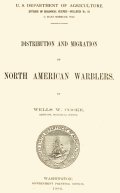
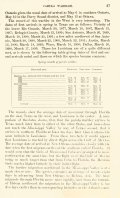 |
|
The Birds Of North And Middle America: A Descriptive Catalogue
Part II: Family Tanagridae - The Tanagers, Family Icteridae - The Troupials, Family Coerebidae - The Honey Creepers, Family Mniotiltidae - The Wood Warblers
Robert Ridgway
Bulletin No. 50
Smithsonian Institution
United States National Museum
1902
Preface: "The present volume is the second of a series which will probably require eight volumes for completion. It contains the following families: Tanagridae (Tanagers), Icteridae (Troupials), Coerebidae (Honey Creepers), and Mniotiltidae (Wood Warblers). Part I, issued in 1901, included the Family Fringillidae (Finches) alone. Part III, which is well under way, will include the Motacillidae (Wagtails and Pipits), Hirundinidae (Swallows), Vireonidae (Vireos), Ampelidae (Waxwings), Ptiliogonatidae (Silken Chatterers), Dulidae (Palm Chatterers), Laniidae (Shrikes), Corvidae (Crows and Jays), Paridae (Titmice), Sittidae (Nuthatches), Certhiidae (Creepers), Troglodytidae (Wrens), Cinclidae (Dippers), Chamaeiidae (Wren-tits), and Sylviidae (Kinglets, etc.), and will probably go to press some time during the present year. The remaining volumes are all in a more or less advanced stage of preparation and it is hoped that these may follow at the rate of two a year. Acknowledgments for the loan of material for use in the preparation of the present volume are due to the persons and public institutions mentioned in Part I (pages xii, xiii), and also to Dr. A. K. Fisher, Mr. William Palmer, and Mr. Paul Bartsch, of Washington, District of Columbia. Both Dr. Fisher and Mr. Palmer should have been mentioned in Part I in this connection, and the inadvertent omission of their names is much regretted. Most of the measurements of specimens for the present volume were made by Mr. J. H. Riley, Mr. Sidney S. Wilson, and Miss Frances E. Swett."
|
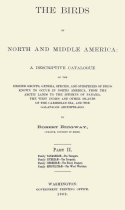
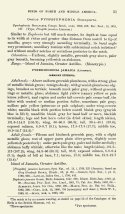
 |
|
A Review Of The American "Golden Warblers"
Robert Ridgway
Volume 8, pages 348-350
Proceedings of the United States National Museum
1885
Opening lines: "In a short paper published in the Proceedings of the Biological Society of Washington, vol. iii, pp. 1-4, I briefly characterized a new form of this group from the island of Cozumel, Yucatan, under the name of Dendroica petechia rufivertex. The birds of this group being much confused, it was found necessary, before the status of the Cozumel bird could be determined, to carefully examine all the material available (embracing considerably more than one hundred specimens from tropical America, besides a very extensive series of D. oestiva from North America); and as the results of this examination may be of interest, a brief synopsis is herewith presented, together with a fuller diagnosis of the Cozumel form, and also another new one from Lower California and western Mexico."
|
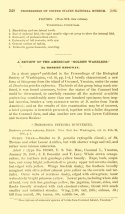 |
|
A Synopsis of the Genus Setophaga
Osbert Salvin
2 colour plates (Setophaga ruficoronata and Setophaga chrysops / Setophaga Bairdi and Setophaga albifrons): J.G. Keulemans
Ibis: Volume 20, Issue 3, pages 302-321
1878
Opening lines: "The genus Setophaga belongs to the American Passerine family Mniotiltidae. One of its chief distinguishing characters is its broad Flycatcher-like bill and its strong rictal bristles, by which its likeness to the Flycatchers of the Old World is still further enhanced. The presence of nine instead of ten primaries, however, at once shows that the true relationship of Setophaga is with the American Mniotiltidae, and not with the Old-World Muscicapidae."
|
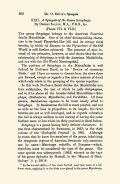
 |
|